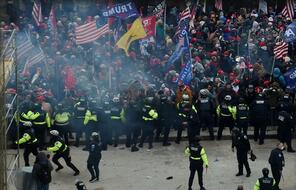Background on the Chicano Movement
At a Glance
Language
English — USSubject
- History
- Social Studies
- Democracy & Civic Engagement
- Racism
The following excerpts from the introduction of The Chicano Movement: Perspectives from the Twenty-First Century, edited by Mario T. Garcia, provide historical context on the Chicano Movement.
The Chicano Movement was the largest and most widespread civil rights and empowerment movement by Mexican-descent people in the United States. The key years of the movement are between 1965 and 1975 . . . Why begin in 1965? That year marked the beginning of the famous grape strike in California’s Central Valley (San Joaquin Valley) led by César Chávez, Dolores Huerta, and the farm workers to establish a union for farm workers that would not only bring them much-deserved wage and benefit increases, but a sense of dignity for their labor and for themselves. 1
The Chicano Movement was characterized at one level by the continuation of a longer civil rights movement, led initially by what I call the Mexcian American Generation of the 1930s through the 1950s that initiated the first major civil rights movement by Mexican Americans in the United States. 2
[The Chicano Movement] called for the Chicano community to be able to control its own resources and determine its own future. It called for community control of its schools, its economy, its politics, and its culture. 3
The Chicano Generation understood that as part of its self-empowerment, it had to have a sense of its history—a history that had been denied it in the schools. Mexicans were not supposed to have a history in the U.S., yet the Chicano Generation instinctively recognised that it had a history or counter-history that it needed to discover. This meant exploring its indigenous and mestizo (Indian and Spanish, and even African and Asian) past: its roots in Mexican history, including Mexico’s war with the U.S.; the Mexican Revolution of 1910; and the history of Mexican immigrants to the U.S. But this was a history it only knew through family and community lore and not systematically studied by historians. This search for a relevant and useable past led to the development of the field of Chicano history as part of the movement’s efforts to establish Chicano Studies programs at universities and colleges. 4
Connection Questions
- According to this reading, what were the goals of the Chicano Movement?
- Why do you think members of the Chicano Movement placed an emphasis on learning Mexican and Mexican American history?
- 1Mario T. Garcia (ed.), “Introduction,” The Chicano Movement: Perspectives from the Twenty-First Century (New York: Routledge, 2014), 1.
- 2Mario T. Garcia (ed.), “Introduction,” The Chicano Movement: Perspectives from the Twenty-First Century (New York: Routledge, 2014), 2.
- 3Mario T. Garcia (ed.), “Introduction,” The Chicano Movement: Perspectives from the Twenty-First Century (New York: Routledge, 2014), 3.
- 4Mario T. Garcia (ed.), “Introduction,” The Chicano Movement: Perspectives from the Twenty-First Century (New York: Routledge, 2014), 3-4.
How to Cite This Reading
Facing History & Ourselves, “Background on the Chicano Movement,” last updated April 28, 2022.
This reading contains text not authored by Facing History & Ourselves. See footnotes for source information.













